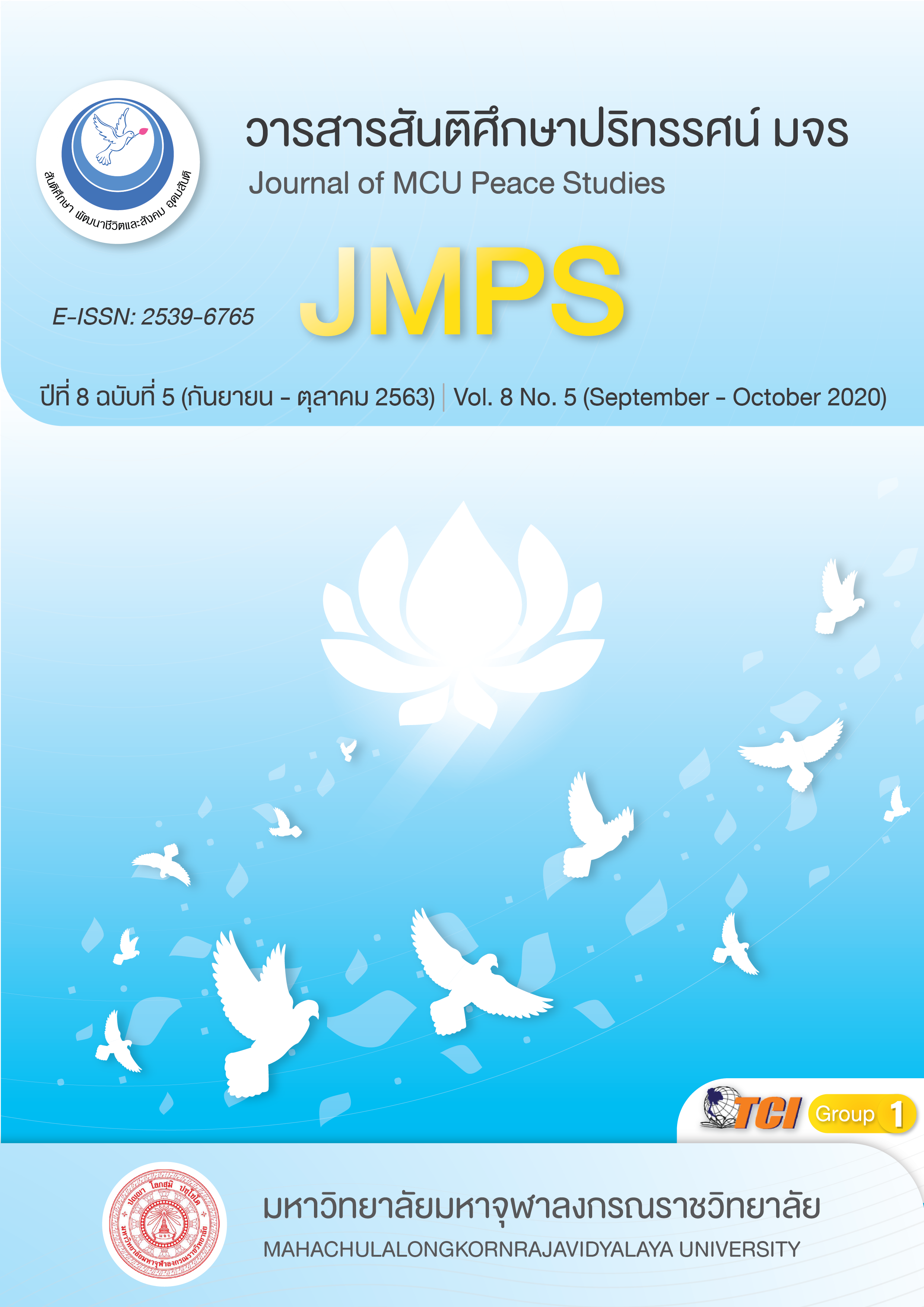ทุนทางสังคมของคณาจารย์โรงเรียนนายร้อยตำรวจ
Main Article Content
บทคัดย่อ
บทความวิจัยเรื่องทุนทางสังคมของคณาจารย์โรงเรียนนายร้อยตำรวจ มีวัตถุประสงค์เพื่อ 1) ศึกษาปัจจัยที่มีอิทธิพลต่อทุนทางสังคมของคณาจารย์โรงเรียนนายร้อยตำรวจ 2) เปรียบเทียบระดับทุนทางสังคมของคณาจารย์โรงเรียนนายร้อยตำรวจ จำแนกตามปัจจัยภูมิหลังส่วนบุคคล และ 3) วิเคราะห์ข้อมูลที่ได้จากการศึกษาเพื่อนำไปสู่แนวทางการพัฒนาทุนทางสังคมให้กับคณาจารย์ในโรงเรียนนายร้อยตำรวจ การวิจัยครั้งนี้เป็นการวิจัยเชิงปริมาณ (Quantitative Research) ทำการเก็บรวบรวมข้อมูลโดยใช้แบบสอบถามจากกลุ่มตัวอย่างที่ใช้ในการศึกษา ซึ่งคัดเลือกจำนวนกลุ่มตัวอย่างตามสูตรของทาโร่ ยามาเน่ (Taro Yamane) ได้แก่ คณาจารย์โรงเรียนนายร้อยตำรวจทั้งหมด จำนวน 106 คน ผลการวิจัยพบว่า 1) ปัจจัยที่มีอิทธิพลต่อทุนทางสังคมของคณาจารย์โรงเรียนนายร้อยตำรวจ จำแนกเป็น 4 ด้าน คือ (1) ด้านเครือข่ายทางสังคม (2) ด้านความไว้วางใจ (3) ด้านวัฒนธรรมองค์กร และ (4) ด้านประสิทธิภาพและประสิทธิผลในการทำงาน ซึ่งพบว่าทั้งสี่ด้านอยู่ในระดับมาก 2) เมื่อเปรียบเทียบระดับทุนทางสังคมของคณาจารย์โรงเรียนนายร้อยตำรวจ จำแนกตามปัจจัยภูมิหลังส่วนบุคคลพบว่า ปัจจัยภูมิหลังส่วนบุคคลไม่ทำให้ระดับทุนทางสังคมของคณาจารย์โรงเรียนนายร้อยตำรวจ ทั้ง 4 ด้าน มีความแตกต่างกัน แต่หากปัจจัยภูมิหลังส่วนบุคคลมีความแตกต่างกันอาจมีผลต่อทุนทางสังคมด้านความไว้วางใจมากกว่าทุนทางสังคมด้านอื่น นอกจากนี้ พบว่า คณาจารย์ที่มีปัจจัยภูมิหลังด้านอายุมากกว่า 50 ปี มีวุฒิการศึกษาระดับปริญญาตรี สำเร็จการศึกษาจากโรงเรียนนายร้อยตำรวจ มีประสบการณ์ทำงานระหว่าง 5 - 10 ปี มีชั้นยศพันตำรวจเอก ดำรงตำแหน่งอาจารย์ 2 และสังกัดกลุ่มงานพลศึกษาและการต่อสู้ป้องกันตัว มีทุนทางสังคมมากกว่าคณาจารย์กลุ่มอื่นๆ 3) ทุนทางสังคมทั้ง 4 ด้าน มีความเชื่อมโยงสัมพันธ์กัน โดยเครือข่ายทางสังคมเป็นเครื่องมืออำนวยความสะดวกในการกระทำกิจกรรมร่วมกัน บนพื้นฐานความเชื่อถือหรือความไว้วางใจซึ่งกันและกัน การติดต่อประสานงานกัน และดำเนินงานตามศักยภาพตามวัฒนธรรมองค์กร ทำให้เกิดพลังในการ
Article Details
ทัศนะและความคิดเห็นที่ปรากฏในบทความในวารสาร ถือเป็นความรับผิดชอบของผู้เขียนบทความนั้น และไม่ถือเป็นทัศนะและความรับผิดชอบของกองบรรณาธิการ ยินยอมว่าบทความเป็นลิขสิทธิ์ของวารสาร
เอกสารอ้างอิง
Areekul, C. (2013). Model Development for Strengthening Social Capital for Being a Sustainable Lifelong Learning Society. (Doctoral Dissertation). Chulalongkorn University. Bangkok.
Adam, F., & Borut, R. (2003). Social Capital: Recent Debates and Research Trends. Social Science Information. 42(4), 155-183.
Aldridge, S., Halpern, D., & Fitzpatrick, S. (2002). Social Capital: A Discussion Paper. London: Performance and Innovation Unit.
Bankston, C., & Zhou, M. (2002). Social Capital as a Process: The Meanings and Problems of a Theoretical Metaphor. Sociological Inquiry. 72, 285-317.
Cabinet Resolution. (9 May 2006). On the Progress of the 10th National Economic and Social Development Plan (2007-2011). nd.
Coleman, J. (1988). Social Capital in the Creation of Human Capital. The American Journal of Sociology. 94, S95-S120.
Durlauf, S. (2002). Symposium on social capital: Introduction. The Economic Journal. 112, 417-418.
Fox, J. (1997). The World Bank and social capital: contesting the concept in practice. Journal of International Development. 9, 963-971.
Luhmann, N. (1979). Trust and Power. Chichester: John Wiley.
Narayan, D., & Cassidy, M. (2001). A dimensional approach to measuring social capital: development and validation of a social capital inventory. Current Sociology. 49, 59-102.
Narayan, D., & Pritchett, L. (1999). Cents and Sociability: Household Income and Social Capital in Rural Tanzania. Economic Development and Cultural Change. 47(4), 871-897.
Phra Suthirattanabundit (Suthit Apakaro). (2004). Networks: Nature, Knowledge and Management. Bangkok: October Publisher.
Piumsombun, P. (2003). Police Administration: New Update. Bangkok: Bannakit.
Portes, A. (1998). Social capital: its origins and applications in modern sociology. Annual Review of Sociology. 24, 1-25.
Rajsamak, P. (2014). Factors That Affect Motivation in Job for Preventing and Suppressing of Police at Samrongtai Police Station in Phrapradaeng District, Samutprakarn Province. (Master’s Thesis). Mahachulalongkornrajavidyalaya University. Ayutthaya.
Sanguanwongwan, W. (2003). Management and Organizational Behavior. Bangkok: Pearson Education Indo China.
Secretariat of the Senate. (2006). The Role of Social Capital and Sustainable Development of the Country. In Document No. 001/49. Bangkok: The Secretariat of the Senate.
Techaatik, S. (2009). The Development of Systematic Community Organization and Social Network for Poverty Problem Solving. (Doctoral Dissertation). Naresuan University. Phitsanulok.
The Office of National Statistics (United Kingdom). (2017) Guide to Social Capital. Retrieved August 23, 2017, from http://webarchive.nationalarchives.gov.uk/.
The World Bank. (2006). Thailand Social Capital Evaluation: A Mixed Methods Assessment of the Social Investment Fund’s Impact on Village Social Capital. Thailand.
Walaisathian, P. (2003). Processes and Techniques of Developer Works. (2nd ed.). Bangkok: Research Fund Office.
Wasi, P. (2015). Strong Community: Thai Social Capital. Bangkok: Social Fund Office, Government Savings Bank.
Wongwaisayawon, S. (1997). Organizational Culture: Concept, Research and Experience. Bangkok: B.J Plate Processor.
Zaheer, A., & Harris, J. (2005). Interorganizational trust. In O. Shenkar and J. Reuer (Eds.), Handbook of strategic alliances. 219-227. London: Sage.


